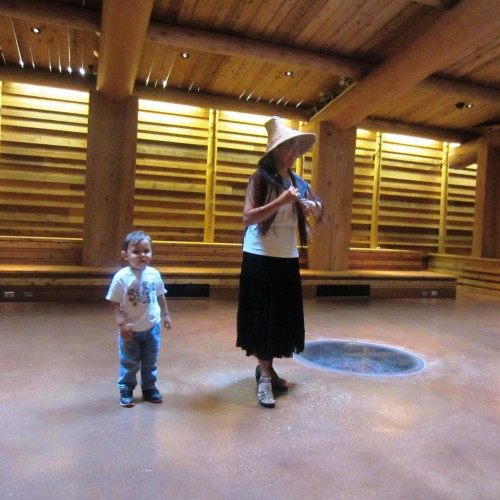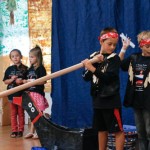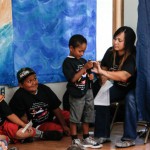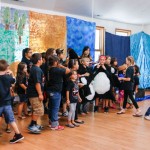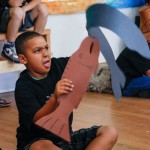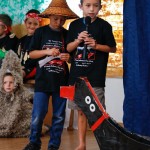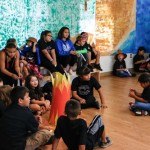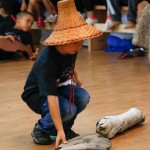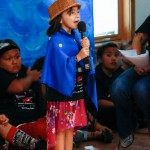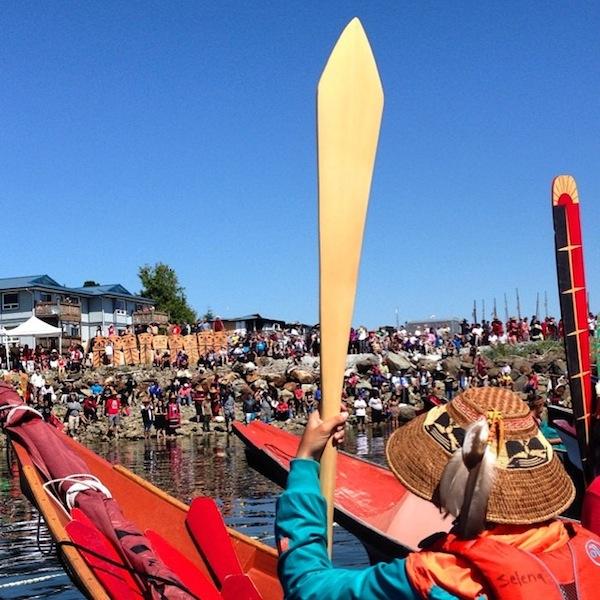Tag: Tulalip
Echoes of her ancestors
Tulalip storyteller Lois Landgrebe discusses life as a storyteller
By Brandi N. Montreuil, Tulalip News
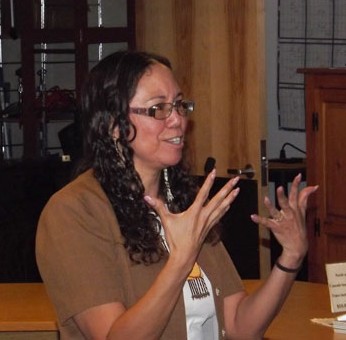 TULALIP – Tulalip tribal member Lois Landgrebe has always been a storyteller. What started out as an entertaining way to comfort her younger sister during childhood has evolved into a beautiful craft she uses to connect people to her tribal culture.
TULALIP – Tulalip tribal member Lois Landgrebe has always been a storyteller. What started out as an entertaining way to comfort her younger sister during childhood has evolved into a beautiful craft she uses to connect people to her tribal culture.
Bilingual in English and her tribe’s traditional language, Lushootseed, she gracefully uses the two languages interchangeably to help the listener understand the historical importance of her stories, while also being entertained.
A steady increase of requests from across the region to hear native stories has catapulted this once local storyteller into a larger audience venue. Through the use of storytelling she is able to educate local communities about tribal history and culture, as well as teach listeners about ethics and morals in the same manner as her ancestors would have.
Tulalip News/See-Yaht-Sub recently sat down with Landgrebe to discuss the art of storytelling and how she uses the words of her elders to continue one of the oldest ways to communicate and pass on history for the next generation.
TN/SYS: When did you begin to tell stories?
Landgrebe: I started with my adoptive baby sister. Our mother passed away when I was 11 and she was 3, so we ended up sharing a bedroom together when we were relocated. She felt alone and scared, so I would go to bed early just to keep her company and ended up starting to tell her stories. I was about 12 or 13 years old when that started, and I learned through my birth mother Carol that her father was a storyteller. He had told stories to my mother and uncles when they were little, so she tells me storytelling is in my blood.
I used to tell stories to the elementary kids on my school bus route, and this was way out in the country boondocks and it takes almost an hour to get to school. I always had a saved seat among the elementary kids because I would carry on a saga of a story that would continue and continue and would last for weeks. They were unique stories that I made up about animals and they absolutely loved it. I would give each animal personality characteristics and they had conflicts and such, so it was like a movie.
TN/SYS: How did you come to tell Tulalip stories?
Landgrebe: I was hired as a Lushootseed language assistant in 1994 and I started learning traditional stories. This is where I also met Dr. Toby Langen and learned from Ray ‘Te At Mus’ Moses, Vi Hilbert and Grace Goedel. Each time I hear a story I am able to retain most of it. I can do Te At Mus’ stories word for word because I have heard them a dozen times; so I really try to keep to his format.
TN/SYS: What is it that you love the most about storytelling? You are naturally a calm, quiet person, but when you tell a story there is a transformation.
Landgrebe: I think most of the time I take kind of a back seat to things in life and such because I am a quiet person, but when it comes to storytelling and presentation, and even the state of the Tulalip Tribes, I take an absolute passion. Sharing that gives me the strength to take the front seat and get out there.
TN/SYS: What is your favorite story to tell?
Landgrebe: I think my favorite is the “Pheasant and Raven”. I like it because it has a repetition in it so I can pause and the audience can blurt out what comes next, because they know exactly what is going to happen because it happens to the other characters.
TN/SYS: Do you prepare yourself before you have to tell a story? Is there a routine that you do right before telling a story?
Landgrebe: Usually my mind is set and I have to give myself a few minutes. Sometimes I think it is the spirit of a storyteller that I take on because sometimes I don’t plan it. I just stand up and introduce or do a song, and it is like stories line up. It is hard to explain. Some that come right to me are in the back of my mind and I know that is the story that needs to be told.
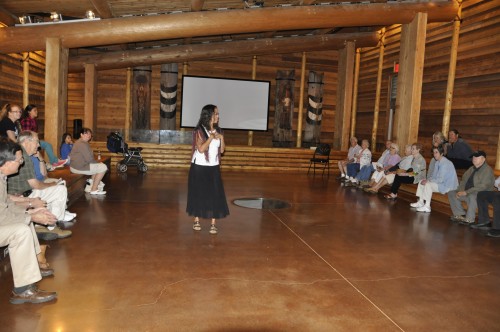
Photo/ Brandi N. Montreuil, Tulalip News
TN/SYS: Do you write your stories down or is it all by memorization and how do you remember all those stories?
Landgrebe: A lot of it is by memorization. I do actually write them down upon request for an article or something.
Sometimes I catch myself in the wrong character. I will get done with “Mink and Whale” and start “Coyote and Rock,’and I will suddenly say whale instead of rock, so you have to be careful, especially in Lushootseed.
TN/SYS: When you tell the stories in Lushootseed do you feel it adds a deeper meaning to you and to your audience?
Landgrebe: Yes I do. I definitely do. I think that sometimes as Lushootseed speakers we take it for granted that we can write it down without thinking about it. And folks watch us write it down and they are amazed. I think that audiences that hear ancient Native languages, that when you first announce that this is endangered, and when you pronounce words that they have never ever heard or think would exist with the hard and guttural sounds, there are people that come up later and say they love to hear it. It is a way of preserving it.
TN/SYS: There are not many storytellers, and just like traditional carving, you have to be taught, you just can’t get up and tell a story. How do you feel as a Tulalip storyteller and Tulalip tribal member to be able to travel to different places with the teachings of your elders and from the people that taught you their stories?
Landgrebe: I feel like an echo of my ancestors. I really adhere to protocol to make sure that they are acknowledged. If the story is from Te At Mus and the Moses family I always make sure, as tribal members, they are mentioned. I always make sure there is that acknowledgement.
It makes me feel nostalgic. Not to toot my own horn because I feel humbled, but when I get on the stage, I feel important to be able to tell these stories. Stories are kept alive. When you are telling them you are breathing new life into them and it keeps that story going. And when you are listening to it, you continue to bring life to it as well, because it can’t move on without going into your ears and mind and being remembered. When I am telling them to little kids, I always pause for a moment and tell them about respect. We have to respect our traditional stories. We don’t know how old these stories are and how long they have been passed on from storyteller to children to another storyteller, so that makes children really stop and listen.
TN/SYS: When did you know that you were ready to step out and tell these traditional stories and that this was your path?
Landgrebe: I think it was right after I started working at the Hibulb Cultural Center. I started to become more known for storytelling with audiences that would visit. I knew I was a storyteller between 2001 and 2010, when I was with the Lushootseed program. They would receive requests to story tell and they would turn them over to me. To me, storytelling isn’t something that gives me anxiety, I feel privileged to be able to tell them.
TN/SYS: Do you consider storytelling an art form?
Landgrebe: Yes definitely. Most would look at it as more of an entertainment, which it was and is a form of entertainment. But there is also, locked in, an obligation to share a, or several, traditional teachings within it. It is almost like keeping in with a design, you can’t necessarily change it too much; you might be able to a little, only to fit to an audience. I have a way of clueing in to what my audience is. If they are younger children I can voice to them. If it was high school students I wouldn’t go, “ok and then they…” I just have that feel and I think as a storyteller you really know your audience and where their level of understanding is, so you can raise that level of complexity based on that.
TN/SYS: Storytelling is a very traditional form of communication, where do you see it fitting into the lives of our youth today, where mostly you compete with them checking Instagram and Facebook?
Landgrebe: That is a hard one. Our lives are very instamatic. Pulling away from technology can sometimes be a treat. Silencing the devices and being in a moment that is not a part of electricity or technology can give a whole another human interaction. Storytelling can be as enriching as watching a movie. You engage with your mind and your ears, and even your heart. When you listen you visualize the words. I have had groups, that when it is over, they are not ready for it to end.
TN/SYS: Can you tell me the elements of storytelling or the process you go through when you are learning a new story?
Landgrebe: I think the best way for me is to just hear it. I grasp onto stories better when I hear it told. I have learned stories on paper or on the Internet, but it takes me a little bit more time to learn them. I think the oral presentation is more susceptible for me to pick up. Sometimes scribbling down an outline because you are not quite as familiar with it as much, but as a storyteller you grasp onto the patterns of the story. A lot of our traditional stories have a pattern, we call them pattern episodes. The same thing will happen more than once in the story to different characters. It helps listeners learn the teaching.
My MO is patterns episode. When I stand up to tell the story it comes out stronger when it is in a pattern than if it wasn’t. Sometimes a story will just come out that way.
TN/SYS: Can you explain what you experience when you are telling a story?
Landgrebe: It is almost like an adrenaline and heaviness on your heart, but your heart is pumping through it. It is hard to explain. You are happy. You pause and you look for a lot of eye contact. It is really unique to see that connection and you pan across and you look to make sure your audience is with you. If you notice they are not then there is something you are not getting across to them.
It is amazing how everything melts away except for yourself and the audience. Afterwards you notice the stage and everything; you want to get off and get away. It is amazing how it all just shrinks away.
TN/SYS: What is your favorite age group to tell stories to?
Landgrebe: Third, fourth and fifth grade. They are old enough to understand the complexities of the story and not too old to think they know it all. Grown ups are a good group to but I really enjoy the youth.
Landgrebe is scheduled to appear on August 30 at 1:30 p.m. at the Hibulb Cultural Center for their monthly storytelling series. For more information on future storytelling events featuring Landgrebe or to request a story, please contact her at moontalk.storyteller@yahoo.com
Brandi N. Montreuil: 360-913-5402; bmontreuil@tulalipnews.com
Hibulb August events to include 3rd anniversary and elder-youth conference
By Brandi N. Montreuil, Tulalip News
 TULALIP – Hibulb Cultural Center and Natural History Preserve has packed their August schedule with exciting events that includes the center’s third anniversary celebration and a community event that brings elders and youth together to share wisdom and stories.
TULALIP – Hibulb Cultural Center and Natural History Preserve has packed their August schedule with exciting events that includes the center’s third anniversary celebration and a community event that brings elders and youth together to share wisdom and stories.
The host of activities kicks off on Sunday, August 3, with Tulalip storyteller Kelly Moses who will be telling traditional Tulalip stories in the center’s longhouse. At 1:00 p.m.
The center will host its 3rd anniversary celebration on August 16, beginning at 10:30 a.m. with Tulalip storyteller Lois Landgrebe, who tells traditional Tulalip stories in English and Lushootseed. Joining Landgrebe will be Jeff Hogan, executive director of Killer Whale Tales, an educational environment program that brings together the art of storytelling and field-based science to inspire listeners to take an active role in conservation of the Pacific Northwest killer whale habitat.
The anniversary event will also feature Tulalip poet, Ceriwyn Hanney, at 12:00 p.m., who will read original work. Immediately following Hanney will be a lecture at 1:00 p.m. given by Father Patrick Twohy, Superior of Jesuits of the Rocky Mountain Mission, who will be discussing his work with Coast Salish communities and his books, “Finding a Way Home” and “Beginnings – A Meditation on Coast Salish Lifeways.”
Tulalip artist Richard Muir Jr., will be holding a peyote stitch demonstration with kits available for purchase at 2:00 p.m. Following at 3:00 p.m., Tulalip master weaver Lance Taylor will also be hosting a demonstration on cedar weaving. To end the anniversary celebration the center, at 4:00 p.m., will feature Travis Holt Hamilton, who will be screening the movie, “More than frybread,” starring Tatanka Means, Gloria Dodge and Ernst Tsosie III.
On August 23, Angela Carpenter will be reading one of her favorite children’s book for the center’s children reading time series. Also scheduled for this series is Lois Landgrebe, who will read one of her favorite children’s books on August 30. Both reading times start at 1:30 p.m.
To wrap up the August event schedule the center will be hosting a campout style community event with the Elders and Youth Transfer of Knowledge Conference, August 26-28. The conference will be held at the Bay View Ranch House in the Warm Beach Camp in Stanwood and will feature Ray Williams, Don Hatch Jr., and Father Pat Twohy S.J., who will tell stories and host engaging discussions with the youth. This event requires registration with Hibulb staff.
August also marks the deadline for film submissions for the center’s second film festival. The deadline for the “Family, Through our Eyes” film festival is midnight August 24. Films submitted should include topics based on family history, heritage and honor and shared connections to recount history, culture and wisdom from your family’s perspective. This year a new youth category, anti-bullying has been added. Other film categories include documentaries, feature films, music documentaries, music videos and shorts. There is no entry fee for submissions. “Family, Through our eyes,” will be held on September 20th.
For more information on the Hibulb Cultural Center’s August events or the “Family, Through our eyes,” film festival, please contact the Lena Jones at 360-716-2640 or Mary Jane Topash at 360-716-2657, or visit their website at www.hibulbculturalcenter.org.
Brandi N. Montreuil: 360-913-5402; bmontreuil@tulalipnews.com
Walgreens opens in downtown Marysville
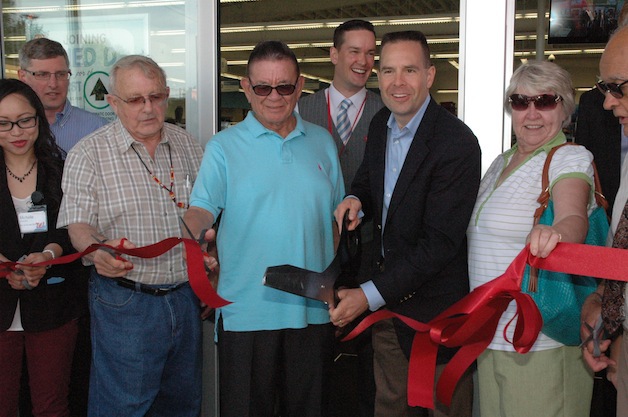
— image credit: Kirk Boxleitner
By Kirk Boxleitner, Marysville Globe
MARYSVILLE — Walgreens opened its Marysville branch at 404 State Ave. with fanfare and charitable contributions to the community July 18.
Marysville Mayor Jon Nehring touted the store’s opening as contributing to the city’s plans for downtown revitalization.
“They’ve already improved this street corner,” Nehring said. “I’m really excited by what the future will bring.”
“The Mayor has already pleaded with me to add a yogurt shop, so I have my marching orders,” Walgreens District Manager Bruce Philip laughed. “Our managers have put together a fabulous group of store employees, who are talented and committed and enjoy taking care of their customers.”
Philip deemed his donations of $250 each, to the Marysville Historical Society and the Tulalip Boys & Girls Club, as evidence of Walgreens long-term commitment to its new community.
“We intend to maintain and even grow these contributions over time,” Philip said. “Our staff lives in this community, so we care what happens here.”
State Sen. John McCoy and Chuck Thacker, unit director of the Tulalip Boys & Girls Club, accepted Walgreens’ oversized check to their club, which McCoy had helped institute 18 years ago.
“It was only the seventh Boys & Girls Club on a Native American reservation,” Thacker said.
“Our kids are our future leaders, so we need to take care of them,” McCoy said.
In their words
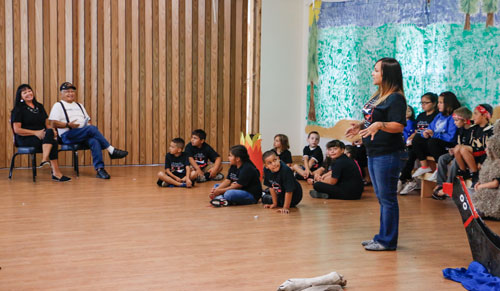
Photo/ Brandi N. Montreuil, Tulalip News
Annual camp immerses youth in traditional language
By Brandi N. Montreuil, Tulalip News
TULALIP – Tulalip youth welcomed their family and friends to the 19th Annual Lushootseed Language Camp where they presented the play “The Seal Hunting Brothers,” a traditional Tulalip story told by Martha LaMont.
Throughout this week language warriors, ages 5–12, have been adding to their expanding Lushootseed vocabulary while learning a condensed version of the original “The Seal Hunting Brothers,” which is comprised of 900 lines. The story explores topics about greed, honesty, providing for family and community, as well as how the Tulalip Tribes emblem came to be the killer whale.
Tulalip Lushootseed teachers and staff, who coordinate the camp every year, teach youth basic Lushootseed phrases, prayers and traditional stories through interactive workstations. The camp, which features two sessions each a weeklong focuses on a different traditional story each year. This year a handful of Quil Ceda & Tulalip Elementary teachers joined youth in learning the traditional values and stories of Tulalip, resulting in a continued collaborative effort between the Marysville School District and Tulalip Tribes.
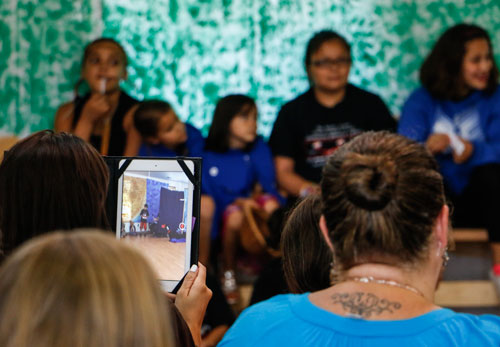
“Each year we pick a theme,” said Lushootseed teacher Natosha Gobin to the audience before the play. “This year we learned about the seal hunting brothers and we are excited for you to hear what the kids learned during camp. Each year we have returning students. We only have ages 5 through 12, but when they reach that 12 year mark, most return to be group leaders and are excited to participate as a group leader.”
This year’s play was held at the Kenny Moses Building in Tulalip, a change from last year’s venue, held at the Hibulb Cultural Center’s longhouse. The longhouse setting is traditionally a place oral history; stories and traditions were told. Despite the change in venue, the youth put on a spectacular play, featuring a decorated set, costumes and props.
Keeping with Tulalip tradition, two witnesses were called forth to watch the play and speak a few words to the youth about their work. This year, the honor went to Tulalip elder Hank Williams, whose mother is Martha LaMont, and Tulalip tribal member Patti Gobin.
“I thank everyone for being here to watch the kids learn our language,” said Williams following the play. “This lifts my heart and makes me feel good to know that these children have learned our language and I hope they do not forget it, and they carry it on.”
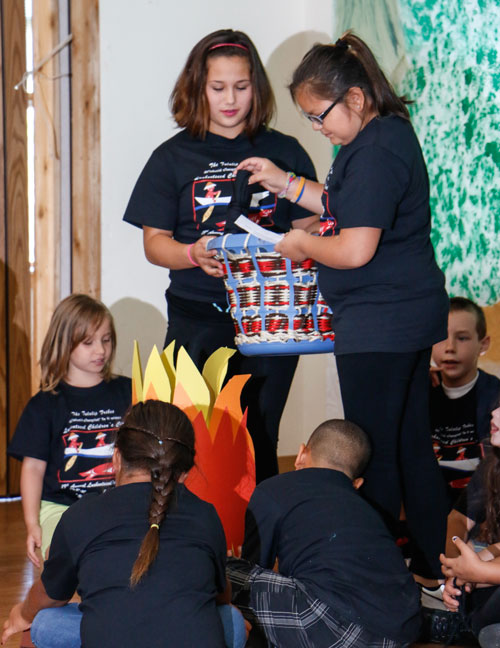
“What I witnessed was a dream come true,” Gobin said to the youth. “ The old people used to say they were waiting for this day. They were waiting for the day when we could speak our traditional language. My grandmother was forced into the boarding school when she was just five years old. She entered speaking Lushootseed and left at the age of 19 speaking English. She refused to teach me our language because she said she didn’t want me to get hurt like she was for speaking Lushootseed. These children are privileged to be able to speak our language. It is exciting to see this. I thank the you children for speaking our language, and I thank the staff for being here to teach it to them.”
For more information about the Lushootseed language or the camp, please contact the Tulalip Lushootseed Department at 360-716-4495 or visit their website at http://www.tulaliplushootseed.com/.
Brandi N. Montreuil: 360-913-5402; bmontreuil@tulalipnews.com
A passion for law
Tulalip tribal member working towards Juris Doctorate
By Brandi N. Montreuil, Tulalip News
TULALIP – For Michelle Sheldon, law has always been visibly present in her life. As a member of a tribe that borders the I-5 corridor in Snohomish County issues regarding jurisdiction, treaty fishing rights, and Indian gaming helped shape the environment she lives in. When it came time to choose an area of study, law was a natural choice.
Encouraged by her parents and with funding help from her Tribe’s higher education department, Sheldon enrolled in Seattle University School of Law’s evening program as a part-time student to earn her Juris Doctorate, which she will receive in December 2016. She plans to use her education in law to aid in the continued development of her Tribe.
“I have always wanted to learn more about the laws that govern the Tulalip Tribes. Because both my undergraduate and graduate studies were in criminal justice, it seemed like a natural fit to pursue a law education and to see how I can help benefit the Tribe one day,” said Sheldon, who currently works in the her Tribe’s legal department and previously was a court clerk at the Tulalip Tribes Tribal Court.
As a legal manager with the Tulalip Tribes, Sheldon sees first-hand how law is used to make contracts, enforce treaty rights, enact justice in criminal proceedings, and resolve housing issues. “I am exposed to a variety of different areas of legal work on a regular basis,” says Sheldon. “As I begin to advance in my legal studies, I am starting to understand how the law factors into each of these practice areas, which in turn, provides me with exposure and opportunities that I would not otherwise have if I worked elsewhere. I am very fortunate to be able to work in this department and apply what I learn from school to my everyday profession. It is truly a rewarding experience and opportunity that I am grateful to have.”
Discovering a passion for law while in her graduate studies, Sheldon says it is important for tribal members to know the laws that govern their tribe. “By having our tribal laws available online, for example, this provides a great resource and opportunity for the membership to read these laws and to perhaps to see what type of legal remedies are available to them.”
A law issue she is enthusiastic about is the Indian Child Welfare Act, which was recently spotlighted in the Supreme Court in Adoptive Couple v. Baby Girl in 2013, commonly known as the ‘Baby Veronica Case.’
“I have always been interested in the area of Indian child welfare as well as issues pertaining to tribal sovereignty, because of what they entail and what they promote, which are our rights to tribal children and the rights to maintaining and protecting our tribal sovereignty,” explained Sheldon.
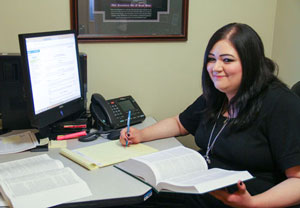
Photo/ Brandi N. Montreuil, Tulalip News
Sheldon explains that because lands on reservations, or Indian country, fall under tribal jurisdiction, these laws can differ from laws outside of Indian country.
“I think what is most interesting about laws that govern Indian Country is that they are created based on their community and enforced to meet the traditions and needs of the community,” said Sheldon. “A good example is our Tulalip Court Elder’s Panel, who offer first-time, non-violent offenders the opportunity to have their charges dismissed in court once they have successfully completed the one-year requirement of this panel. This panel is a healing panel of sorts, by often requiring many of its participants to write letters of apology to those they have wronged and to sometimes engage in substance abuse treatment for example. Most importantly, these individuals are required to be accountable to our tribal elders, who have taken the time to voluntarily participate on this panel. I think this is an excellent example of how Indian country can differ from our non-Indian country counterparts.”
Despite juggling full-time employment in a busy legal department and her part-time studies, Sheldon says she is determined to finish school and credits her biggest motivators, her parents, in helping her continue.
“They provided me with the inspiration to pursue my goals by always encouraging me that I could do it, no matter how hard or challenging it was. Once I decided to pursue a degree in law, they offered me endless amounts of encouragement and support, which in turn gave me the confidence to pursue my goals. I will always be thankful to them for this,” said Sheldon, who also credits the educational opportunities provided by her Tribe as a factor in her ability to obtain her Juris.
“I will always be thankful to the Tribe and to the Higher Education department for always looking out for me and for making sure that I have everything that I need to have the most beneficial educational experience as a student, so that I can continue to pursue my educational goals,” Sheldon said.
Sheldon advises anyone embarking on their own higher education goals to talk with the admission office at the school they are interested in, as they can help you prepare for critical documents you will need while applying.
“Another opportunity that I think would be beneficial for any tribal members who are thinking about attending law school is to ask your school of choice to visit an actual class session. It is also a great way to interact with the law professors and other law school students who are always willing to share their experiences with you and to share great tips on what to expect once you are admitted to the school.”
Brandi N. Montreuil: 360-913-5402; bmontreuil@tulalipnews.com
Canoe Journey Message: Protect Our Fragile Environment
En route to the territory of the Heiltsuk First Nation, pullers in the 2014 Canoe Journey traveled through territory so beautiful it will be impossible to forget: Rugged, forested coastlines; island-dotted straits and narrow, glacier-carved passages; through Johnstone Strait, home of the largest resident pod of orcas in the world, and along the shores of the Great Bear Rainforest, one of the largest remaining tracts of unspoiled temperate rainforest left in the world.
They also traveled waters that are increasingly polluted and under threat.
Pullers traveled the marine highways of their ancestors, past Victoria, British Columbia, which dumps filtered, untreated sewage into the Salish Sea. They traveled the routes that U.S. energy company Kinder Morgan plans to use to ship 400 tanker loads of heavy crude oil each year.
Canoes traveling from the north passed the inlets leading to Kitimat, where heavy crude from Enbridge Inc.’s Northern Gateway pipeline would be loaded onto tankers bound for Asia, a project that Canada approved on June 17.
RELATED: First Nations Challenge Enbridge’s Northern Gateway Pipeline in Court
Canoes from the Lummi Nation near Bellingham passed Cherry Point, a sacred and environmentally sensitive area where Gateway Pacific proposes a coal train terminal; early site preparation was done without permits and desecrated ancestral burials.
RELATED: Lummi Nation Officially Opposes Coal Export Terminal in Letter to Army Corps of Engineers
Young activist Ta’kaiya Blaney of the Sliammon First Nation sang of her fears of potential environmental damage to come in her song, “Shallow Waters”:
“Come with me to the emerald sea / Where black gold spills into my ocean dreams.
“Nothing to be found, no life is around / It’s just the sound of mourning in the air.”
RELATED: Young Sliammon Actor/Singer Campaigns Against Pipeline
Canoes from Northwest indigenous nations arrived in Bella Bella, British Columbia on July 13; the gathering continues until July 19 with cultural celebrations, a rally against Enbridge’s Northern Gateway pipeline, and an indigenous economic summit. The ceremonies are being livestreamed online at Tribal Canoe Journeys 2014 :: Qatuwas Bella Bella.
Mike Williams Sr., chief of the Yupiit Nation and member of the board of First Stewards, noted that the Canoe Journey route calls attention to the fragile environment that’s at stake. First Stewards, an indigenous environmental advocacy group, will host a symposium on “Sustainability, Climate Change & Traditional Places” from July 21–23 in Washington, D.C.
“The Canoe Journey is a really big statement to us to hang onto our culture and our way of life, and to bind people together,” said Williams, who is also a well-known musher. “In the Iditarod, there are pristine places but there are also old mining towns [on the route] where we’re told not to drink the water.”
The parallels between the water issues encountered on the Iditarod and the Canoe Journey are unmistakable, he added.
“In the Canoe Journey, there are pristine waters and there are waters that contains toxic substances,” Williams said. “There’s oil and the continuous leaking of pipelines. It happens.”
Not only does it happen, but it does not go away. Prince William Sound has never totally recovered from the Exxon Valdez oil spill, Williams said. Likewise, he added, if the Northern Gateway pipeline, the coal trains and increased shipping come to fruition, an environmental disaster is inevitable.
“It’s going to happen,” Williams said. “There has to be total, thoughtful conversation for everyone—consider all the possible impacts. And there has to be meaningful consultation with the tribes. They have to weigh in on that. We’ve got to make it 100 percent fail-safe or don’t do it.”

State Senator John McCoy, D-Tulalip, is a citizen of the Tulalip Tribes. He is the ranking member of the Senate Energy, Environment & Telecommunications Committee, which focuses on such issues as climate change, water quality, toxic chemical use reduction and cleanup, and management of storm water and wastewater.
“I think the message is, pollution is occurring everywhere,” McCoy said of the takeaway from the Canoe Journey. “It’s a worldwide problem, and it needs to be addressed. If we keep polluting our water, we’re going to be in big trouble. Water is the essence of life.”
Canoes were underway for Bella Bella on July 9 as Governor Jay Inslee announced that he wants to increase the recommended fish-consumption rate in the state from 6.5 grams to 175 grams a day—that’s good news for indigenous peoples, for whom fish is important culturally, spiritually and as a food. But for 175 grams of fish to be considered safe to eat, businesses that pollute will have to conform to tougher pollution control standards.
RELATED: New Fish Consumption Guidelines More Political Than Scientific, Northwest Tribes Say
Inslee’s plan for how toxic substances will be controlled in expected in December. It will require legislation, McCoy said.
Jewell James is coordinator of the Lummi Treaty Protection Task Force and a leader in the effort to prevent a coal train terminal from being built at Cherry Point, a sacred area for the Lummi people and an important spawning ground for herring, an important food for salmon.
James said environmental degradation is just part of a series of historical traumas set upon Indigenous Peoples: First, the diseases that came after contact; then the treaty era and the relocation to reservations; then the cultural and spiritual oppression of the boarding school era, and then the termination era.
“Yet we continue to exist,” James said. And the Canoe Journey, now in its 23rd year, has helped “revitalize and breathe new life into our cultural knowledge” given that journey gatherings are venues for the passing down of stories about how the ancestors lived in and cared for the environment that sustained them.
RELATED: 10 Traditional Foods You Might Enjoy During a Canoe Journey
James hopes people on the Canoe Journey connect with and carry on those stories and values.
“There are messages in those stories,” he said. “And within those stories there are sacred symbols that mean something—that you have to be careful with what you do, and others have to be careful with what they do, to Mother Earth.”
Read more at http://indiancountrytodaymedianetwork.com/2014/07/17/canoe-journey-message-protect-our-fragile-environment-155904?page=0%2C1
Grove Church iheart outreach campaign comes to Tulalip
By Kim Kalliber, Tulalip News and Patty Thometz, Grove Church
Staff and volunteers from the Grove Church in Marysville continue to expand their iheart outreach campaign in an effort to better reach out to the Marysville and Tulalip communities.
Each year, 150 plus volunteers pay a fee to go on a missions’ trip to serve our community by beautifying grounds of local schools, repairing/painting, building shelters, park benches and dug-outs for parks and baseball fields around Marysville.
Patty Thometz, Children’s Pastor at the Grove Church said, “This summer, we will be expanding our reach to children through iheartGO, a big block party for kids at various locations in Marysville. We want to go where there’s a lot of children.”
Youth in fourth through eighth grade are encouraged to volunteer a week of their time to serve others and give back to their communities. This includes everything from set up, clean up, leading the games and crafts.
The Tulalip Boys and Girls Club is one of five host locations. Chuck Thacker, Unit Director of the Tulalip Boys and Girls Club, has warmly invited the Grove Church campaign folks to partner with them for a day of fun, bounce houses, face painting, crafts, games, free hot dogs and much more. This event will be on Friday, August 8, from 11:00 a.m. to 2:00 p.m.
“It’s wonderful what you [Tulalip] do for the kids at the Boys and Girls Club and the Grove Church is excited to be a part of this learning partnership. I love outreach and I love working with kids,” said Thometz, with a smile.
For more information about the Grove Church and its outreach programs, please visit grovech.org.
Salmon seminars
Free seminars at Cabela’s Tulalip this weekend are pointed toward summer salmon seasons, and include the following highlights:
Saturday: 11 a.m., Catching Silvers on the Fly, with Mike Benbow; noon, Fall Salmon Fishing in the River, with Jim and Jennifer Stahl of NW Fishing Guides; 1 p.m., Chasing Salmon in the Salt, with Gary Krein; and 2 p.m., Egg Cure Secrets, with Cabela’s Outfitters
Sunday: 11 a.m., Rigging Your Salmon Rod, hosted by Jim and Jennifer Stahl; noon, Chasing Salmon in the Salt, with Nic Kester; 1 p.m., Salmon Love Herring, Strategies, Tips and Secrets, with Cabela’s Outfitters; and 2 p.m., Fall Salmon Fishing in the River, with Jim and Jennifer Stahl.
Conference seeks to join Native American carvers and museum professional in preservation of cultural items
By Brandi N. Montreuil, Tulalip News
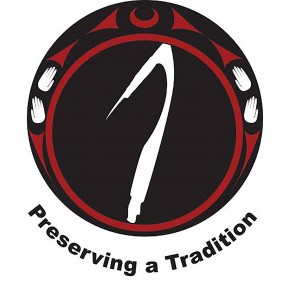 TULALIP – The conservation and preservation of Native American poles, posts, and canoes will be the focus of the first symposium hosted by the Hibulb Cultural Center and Natural History Preserve on July 21- 22, held at the Tulalip Resort Casino.
TULALIP – The conservation and preservation of Native American poles, posts, and canoes will be the focus of the first symposium hosted by the Hibulb Cultural Center and Natural History Preserve on July 21- 22, held at the Tulalip Resort Casino.
Poles, Posts, and Canoes will bring together Native American and non-Native museum professionals, and contemporary carvers to discuss the challenges in preserving and exhibiting wood carvings, while also examining the Native and non-Native viewpoint on preserving these historic wood items.
“When I first came to work here four years ago, one of the things that struck me most was the fact that we have a number of poles and canoes in the collections,” said Hibulb Conservator, Claire Dean. “These large wooden objects are a real challenge for museums everywhere, regardless of their cultural background. It is because these tend to be very big and heavy to move around. Actually they are quite difficult to display safely. If they are old, and deteriorated they become fragile. Here we have a disproportionate number of them, and that has to do with the fact that the community here, the poles and canoes, are a central part of the material culture here, and when you have a culture with that in its background, then you are going to run into them as more of a challenge than other cultures where they don’t exist. I am also very aware that we have carvers here in the community, and I like the idea of trying to involve them somehow.”
Dean explains the idea for the Poles, Posts, and Canoes Symposium developed from a conservator conference Dean attended, which highlighted the preservation of the Maori Waka Taua Project, or war canoe project, at the National Museum of Scotland. During the conference the issue of preserving cultural items such as wood canoes, a responsibility of Dean’s as a conservator at Hibulb, was examined. Dean learned how the war canoe, in derelict condition, was discovered during an examination to be a product of three canoes merged together, instead of one carving, making the preservation of the canoe difficult. With the help of highly-regarded Maori artist George Nuku, the canoe was restored using acrylic material to fashion a new sternpost, blending traditional materials with contemporary elements to safely preserve the canoe for display.
“We were already thinking about our conference and immediately I thought, ‘this is it! This is exactly what I have been thinking about. This idea of incorporating traditional carvers into the care of the collections.’ Not that I am suggesting that we are going to make lots of plexiglas poles, but it is this idea of working with artists who are very much a part of the community,” said Dean.
The two-day conference will feature a non-traditional conference format featuring informal presentations regarding the care of past, present, and future cultural
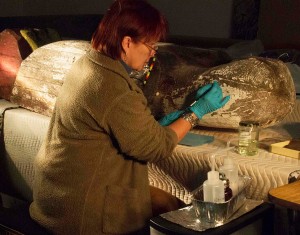
items.
“I thought it was a great opportunity to have a conference where we could actually sit down and really talk about this, and while this isn’t the first time that a meeting has been held about this topic, it is the first time, that I am aware of, that it has been hosted by a tribal community and held on tribal lands,” said Dean.
“We will have little sessions where presenters will be giving 15 minute talks, so they are very short and to the point,” continued Dean. “I have asked the presenters to prepare their presentations to spark thought and discussion. We will have four or five of these 15-minute talks, then we take a coffee break and for at least an hour and half there is no program. It will be open discussion. It is a chance for the folks attending to ask questions of the presenters and the carvers. This is a bit of a risk, because it is not a conventional way of doing a conference, but I think it is more in keeping with how things are done in communities such as this one.”
Presenters will include George Nuku, Maori artist, Graeme Scott from the Glasgow Museums in Scotland, Richard Feldman from the Eiteligorg Museum of American Indians and Western Art, Costantino Nicolizas from the Ecole Des Hautes Etudes en Sciences Sociales in France, Kelly McHugh from the National Museum of the American Indian, Tessa Campbell from the Hibulb Cultural Center, and Sven Haakanson from the Burke Museum of Natural History and Culture, and many others.
Following the two-day conference Hibulb Cultural Center will host a three-day workshop featuring Michael Harrington, Felix Solomon, and Andrew Todd on caring for totem poles held on July 23 – 25, at the Hibulb Cultural Center and Natural History Preserve.
Registration is open until the day of conference, and limited space available for the workshop. Registration fee for the conference is $350 with a discount fee of $250 for students, and the workshop fee is $350. Both events include breakfast and lunch. A special event featuring keynote speakers, Charles Stable and George Nuku, will be held on the evening of July 21, at the Hibulb Cultural Center free of cost and open to the public.
“This isn’t just about the conservation and preservation of old poles, posts, and canoes, which we have here in collections, it is also about the preservation of the tradition of carving these things, and how those two areas of interest intersect. How the collections here can be of help to contemporary carvers, and how the methods and materials in the knowledge of contemporary carvers can actually be of use to conservators.”
For more information on registration for the symposium or the workshop, please visit the Hibulb Cultural Center’s website at www.hibulbculturalcenter.org.
Brandi N. Montreuil: 360-913-5402; bmontreuil@tulalipnews.com



